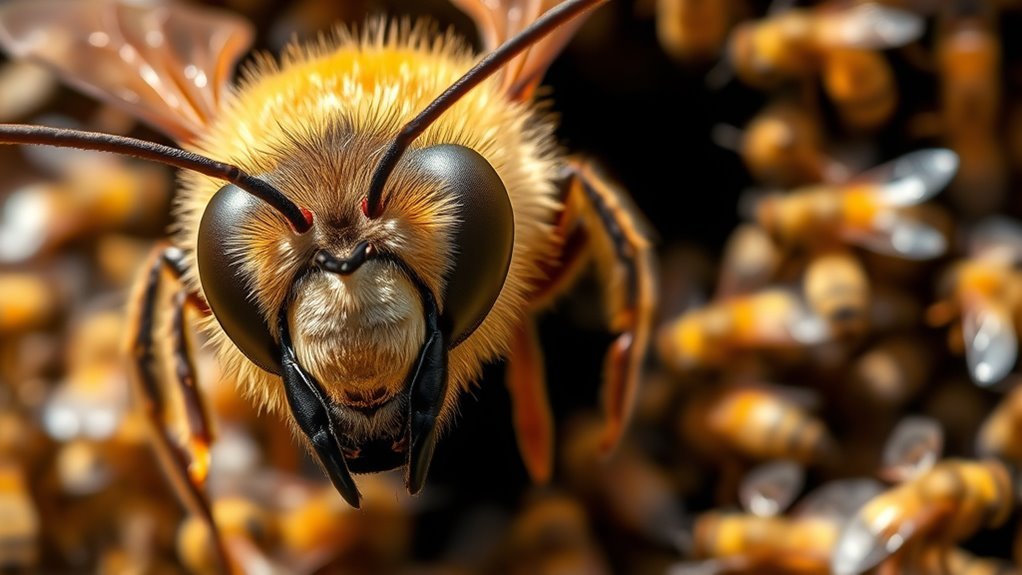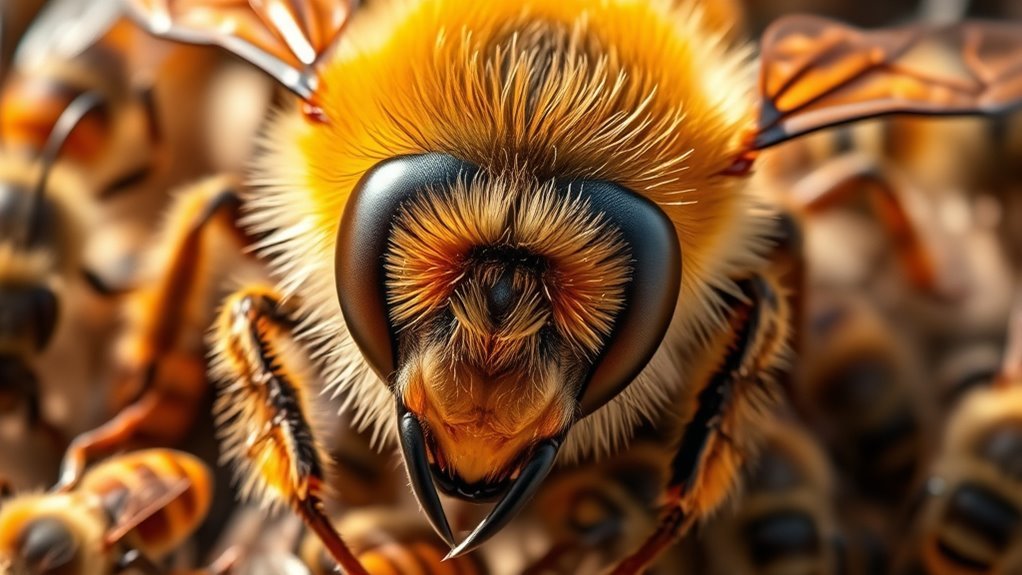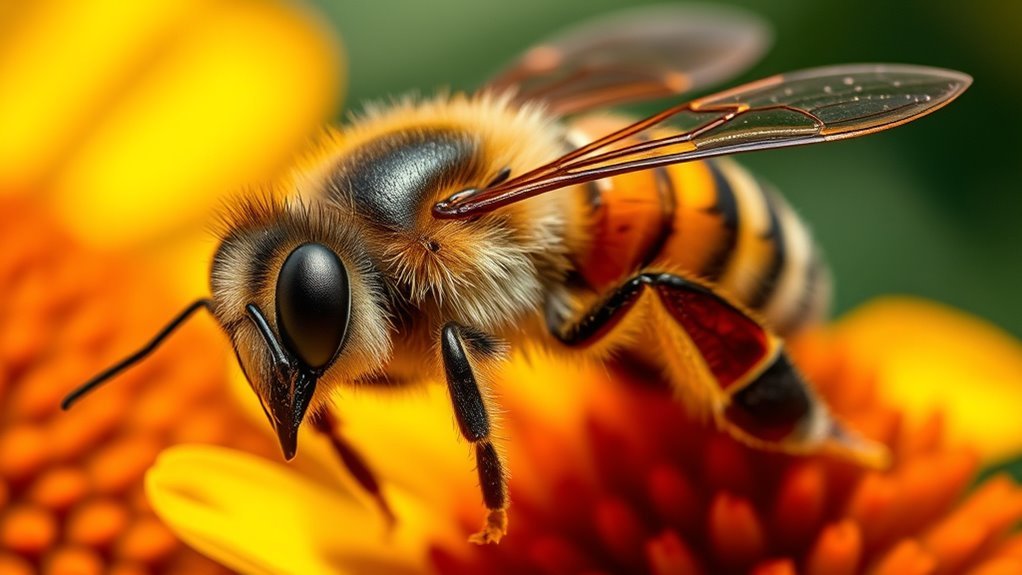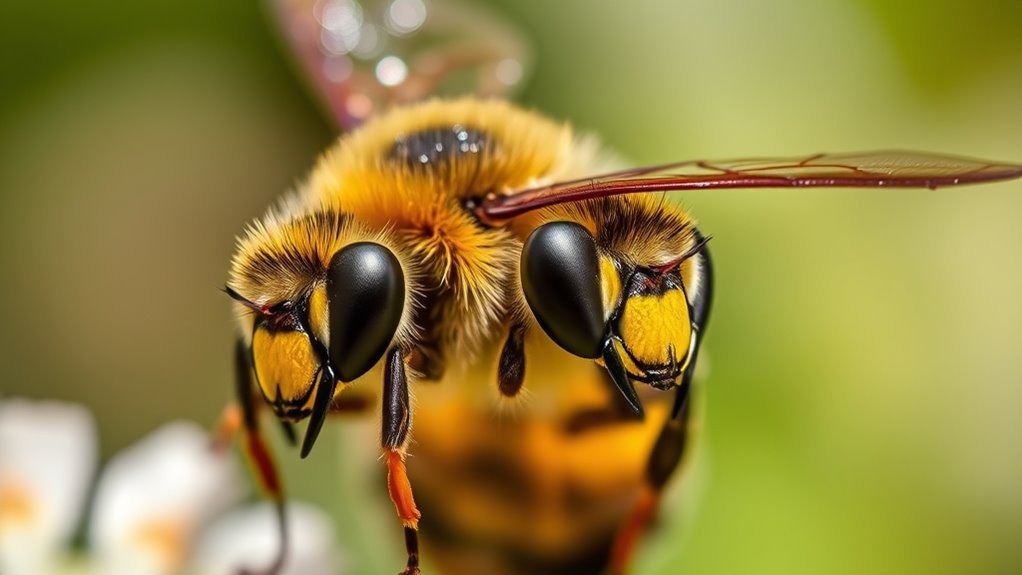Drone bees are male insects uniquely designed for mating within the hive. You’ll notice they’re larger, with bigger eyes and no stingers, unlike female worker bees who forage and maintain the hive. Their sole function is to mate with virgin queens, ensuring genetic diversity crucial for colony health. Without drones, reproduction and the hive’s long-term survival would falter. Understanding their role reveals fascinating aspects of hive dynamics and genetics you’ll find intriguing.
The Role of Drone Bees in the Hive

Although drone bees don’t gather nectar or pollen like worker bees, their primary role in the hive is essential: they exist solely to mate with a queen from another colony, ensuring genetic diversity and the continuation of the species. You’ll find that drone bee roles are specialized and limited compared to the multifunctional worker bees. Regarding hive dynamics, drones contribute indirectly by supporting reproductive success, which maintains colony health and evolution. Their presence affects resource allocation; the colony must balance energy devoted to drones against other hive needs. Understanding drone bee roles reveals how freedom in nature is tied to genetic exchange, allowing colonies to adapt and thrive. Therefore, even though drones don’t perform daily tasks, their reproductive function is critical to the hive’s long-term survival and ecological freedom.
Biological Differences Between Drone and Worker Bees

Understanding the reproductive role of drone bees naturally leads to examining how their biology differs from that of worker bees. Drone bee anatomy is specialized for mating; they possess larger eyes and robust thoraxes to support strong flight muscles, enabling them to locate and mate with queens mid-air. Unlike worker bees, drones lack stingers and have no structures for pollen collection, reflecting their singular reproductive purpose. Worker bee duties, by contrast, encompass foraging, hive maintenance, and brood care, requiring smaller eyes and pollen baskets on their hind legs. Their anatomy supports these diverse tasks, including a barbed sting for defense. These biological differences underscore the distinct evolutionary paths shaped by the hive’s division of labor, granting each bee type a unique role essential to colony survival and reproductive success.
How to Identify Male and Female Bees

To accurately identify male and female bees, you need to observe distinct physical characteristics such as size, eye shape, and the presence or absence of a stinger. You’ll also notice behavioral differences, including flight patterns and roles within the hive. Understanding these traits allows you to distinguish drones from worker bees with scientific precision.
Physical Differences
Distinguishing male drone bees from female worker bees involves examining specific physical traits that are consistent and measurable. When you perform a size comparison, drones are especially larger and bulkier, with a more robust abdomen designed for reproductive functions. Female workers, in contrast, are smaller with sleeker bodies optimized for foraging and hive maintenance. Wing structure also differs; drones possess larger, broader wings that aid in their flight during mating flights, whereas worker bees have proportionally smaller wings adapted for agile, precise movements. Additionally, drones lack the stinger present in females, reflecting their non-defensive role. By focusing on these physical characteristics—body size, wing morphology, and abdominal shape—you can accurately identify the sex of a bee in the hive without guesswork, empowering your understanding of bee biology and freedom to explore.
Behavioral Traits
Although physical traits provide clear indicators, observing behavioral patterns offers equally reliable clues to differentiate male drone bees from female worker bees. You’ll notice drones exhibit distinct mating behavior; they leave the hive to congregate in drone congregation areas, seeking queens for reproduction. In contrast, female workers engage in varied social interactions within the hive, performing tasks like foraging, brood care, and hive maintenance. Drones lack these labor roles and rarely participate in hive defense or resource gathering. By focusing on these behaviors—drones’ exclusive pursuit of mating and workers’ diverse social responsibilities—you can confidently identify male and female bees. Understanding these behavioral traits not only clarifies gender roles but also highlights the freedom each bee type has within the colony’s social structure.
Reproductive Functions of Drone Bees
When you examine the reproductive functions of drone bees, you’ll find they serve a singular, essential role within the hive’s lifecycle. Drones are exclusively responsible for the mating process with virgin queens, ensuring genetic diversity and colony vitality. Their reproductive anatomy is specialized for this task, equipped with large eyes and robust flight muscles to locate and mate in midair during nuptial flights. Maintaining reproductive health is critical; drones develop fully functional reproductive organs but do not participate in nectar or pollen collection. You’ll notice that their lifespan and energy reserves are focused solely on optimizing mating success. This reproductive specialization underscores the evolutionary strategy of the hive, where drones act as the genetic vectors, enabling the continuation and adaptation of the colony’s lineage through precise, goal-oriented reproductive function.
Lifecycle of a Drone Bee
The lifecycle of a drone bee spans several distinct stages, each critical for its development and eventual reproductive role. You’ll observe drone development beginning as an unfertilized egg, laid by the queen in a larger cell designed specifically for drones. After approximately 24 days, the drone emerges, progressing through larval and pupal stages inside the hive. As a mature drone, its sole purpose is to mate with a queen during flight. The drone’s life span is relatively short, typically lasting several weeks to a few months, depending on environmental conditions and hive dynamics. Unlike worker bees, drones do not participate in foraging or hive maintenance, focusing entirely on reproduction until they are expelled or perish after the mating season.
The Importance of Drones to Colony Genetics
Since drone bees are the only male members of the colony, their genetic contribution is vital for maintaining genetic diversity within the hive. You should understand that drones participate in specific mating strategies, flying to drone congregation areas where they mate with virgin queens from other colonies. This process prevents inbreeding and promotes a robust gene pool, essential for colony resilience and adaptability. By mating with multiple drones, the queen guarantees offspring inherit varied genetic traits, enhancing disease resistance and environmental adaptability. Your appreciation of these dynamics reveals how drones, though non-foraging, are pivotal in sustaining the colony’s genetic health. Their role in mating strategies directly influences the genetic diversity that underpins the hive’s survival and evolutionary success.
Challenges Faced by Drone Bees
Understanding the genetic importance of drone bees highlights the pressures they face throughout their lifecycle. You’ll find that drones must navigate numerous environmental threats, such as predation, adverse weather, and habitat loss, which challenge their survival. Unlike worker bees, drones don’t gather food or defend the hive, limiting their roles and increasing vulnerability. Their survival strategies focus on maximizing mating success during limited flight periods, as failure to mate results in death after reproduction. Additionally, drones are susceptible to colony-level decisions; during resource scarcity, colonies may eject drones to conserve energy. These factors emphasize the delicate balance drones maintain between fulfilling their genetic role and overcoming environmental pressures, underscoring the complexity of their existence within the hive’s social structure.

